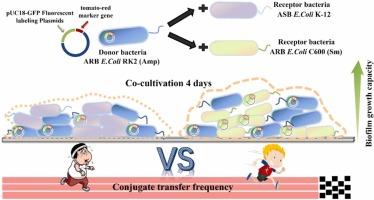Biofilm formation mechanisms of mixed antibiotic-resistant bacteria in water: bacterial interactions and horizontal transfer of antibiotic-resistant plasmids
IF 12.2
1区 环境科学与生态学
Q1 ENGINEERING, ENVIRONMENTAL
引用次数: 0
Abstract
Over 95% of bacteria on water supply pipeline surfaces exist in biofilms, which are hotspots for antibiotic resistance gene (ARG) transmission. This study established mixed biofilm culture systems on a metal iron substrate using Escherichia coli: antibiotic-sensitive bacteria (ASB) and antibiotic-resistant bacteria (ARB). The growth rate and extracellular polymeric substances (EPS) content of mixed biofilm surpassed single-species biofilms due to synergistic interactions among different bacteria. However, the composition of mixed biofilms formed by ASB and ARB became unstable after 72 h, linked to reduced polysaccharide proportions in EPS and inter-bacterial competition. The bacterial composition and conjugative transfer frequency of ARGs in mixed biofilms indicate that biofilm formation significantly enhances horizontal transfer of ARGs. Notably, the conjugative transfer frequency of the mixed biofilm formed by two ARB increased 100-fold within five days. In contrast, the conjugative transfer frequency in the mixed biofilm formed by ASB and ARB was unstable; inter-bacterial competition led to plasmid loss associated with horizontal transfer of ARGs, ultimately resulting in biofilm shedding. Furthermore, genes associated with ARG transfer and biofilm growth up-regulated by 1.5 − 6 and 2 − 7 times, respectively, in mixed biofilm. These findings highlight a mutually reinforcing relationship between biofilm formation and horizontal ARG transmission, with significant environmental implications.

水中混合抗生素细菌的生物膜形成机制:细菌相互作用和抗生素质粒的水平转移
供水管道表面 95% 以上的细菌存在于生物膜中,而生物膜是抗生素耐药基因 (ARG) 传播的热点。本研究利用大肠杆菌在金属铁基质上建立了混合生物膜培养系统:抗生素敏感菌(ASB)和抗生素耐药菌(ARB)。由于不同细菌之间的协同作用,混合生物膜的生长速度和胞外聚合物质(EPS)含量超过了单种生物膜。然而,ASB 和 ARB 形成的混合生物膜的组成在 72 小时后变得不稳定,这与 EPS 中多糖比例降低和细菌间竞争有关。混合生物膜中 ARGs 的细菌组成和共轭转移频率表明,生物膜的形成大大增强了 ARGs 的水平转移。值得注意的是,由两种 ARB 形成的混合生物膜的共轭转移频率在五天内增加了 100 倍。相比之下,ASB 和 ARB 形成的混合生物膜的共轭转移频率并不稳定;细菌间的竞争导致与 ARGs 水平转移相关的质粒丢失,最终导致生物膜脱落。此外,在混合生物膜中,与 ARG 转移和生物膜生长相关的基因分别上调了 1.5 - 6 倍和 2 - 7 倍。这些发现凸显了生物膜形成与 ARG 水平传播之间相辅相成的关系,对环境具有重要影响。
本文章由计算机程序翻译,如有差异,请以英文原文为准。
求助全文
约1分钟内获得全文
求助全文
来源期刊

Journal of Hazardous Materials
工程技术-工程:环境
CiteScore
25.40
自引率
5.90%
发文量
3059
审稿时长
58 days
期刊介绍:
The Journal of Hazardous Materials serves as a global platform for promoting cutting-edge research in the field of Environmental Science and Engineering. Our publication features a wide range of articles, including full-length research papers, review articles, and perspectives, with the aim of enhancing our understanding of the dangers and risks associated with various materials concerning public health and the environment. It is important to note that the term "environmental contaminants" refers specifically to substances that pose hazardous effects through contamination, while excluding those that do not have such impacts on the environment or human health. Moreover, we emphasize the distinction between wastes and hazardous materials in order to provide further clarity on the scope of the journal. We have a keen interest in exploring specific compounds and microbial agents that have adverse effects on the environment.
 求助内容:
求助内容: 应助结果提醒方式:
应助结果提醒方式:


